Exploring Bedspaces: Enhancing Garden Design and Functionality


Intro
The relationship between outdoor spaces and human well-being is profound, often hovering just below our conscious awareness. With the right arrangements, gardens can transform from simple patches of green to multifunctional havens. One of the most intriguing developments in garden design is the concept of bedspaces. This idea not only promotes a vibrant environment but also integrates practical elements to enhance one’s outdoor experience.
Creating bedspaces within gardens allows for flexibility, encouraging creative expression while catering to personal needs. Before diving into the pros and cons of bedspaces, let’s first explore what bedspaces truly mean in the context of a garden and how they can revolutionize our interaction with nature.
Bedspaces can be seen as designated areas within a garden, tailored specifically for various activities, such as planting vegetables, hosting gatherings, or basking in the sun. The careful design and arrangement can yield an inviting space that raises both aesthetic beauty and functionality markedly.
Market Insights
In recent years, the gardening concept has evolved significantly, influenced by changing demographics and desires for greener living. With an increasing number of homeowners focusing on sustainability and self-sufficiency, bedspaces are now a hot topic.
Current Trends in Garden Design
The shift towards organic gardening and permaculture principles is not a mere fad; it reflects a genuine appreciation for nature and its benefits. Today, many individuals relish the prospect of growing their own food, lending to the rise of edible landscapes. Bedspaces are often designed with this principle in mind, creating adaptable areas that facilitate growing various plants without the stress of traditional landscaping techniques. Incorporating vertical gardens or raised beds is also gaining traction, giving older gardens a fresh spin. Residential gardens that prioritize balance and biodiversity are proving to be wildly appealing, drawing in both homeowners and investors looking for unique properties.
Predictive Analysis of Future Developments
Looking ahead, it's reasonable to conclude that the integration of bedspaces will continue to grow. Factors such as urbanization and environmental awareness are likely to spur innovative designs in gardens. As homes evolve and the understanding of sustainable practices spreads, one can anticipate the popularity of multifunctional outdoor areas to skyrocket. Projections indicate that an increasing number of homes will feature numerous bedspaces catering to diverse uses like relaxation, gathering, or even meditation amidst greenery.
In essence, the need for outdoor spaces that offer utility and comfort is here to stay. Homeowners, and those interested in maximizing their properties' value, should take note. With a bit of creative thinking and intentional design, bedspaces can indeed turn ordinary gardens into extraordinary reflections of personal vision and style.
Understanding Bedspaces
The concept of bedspaces transcends mere aesthetics in garden design. Understanding bedspaces is critical not just for enhancing the visual appeal of a garden, but also for addressing practical concerns regarding space, plant health, and environmental impact. By grasping the essence of what bedspaces are and how they function within the broader context of gardening, homeowners and investors can make informed choices that align with their goals.
Definition of Bedspaces
At its core, a bedspace refers to a designated area within a garden allocated specifically for growing plants, vegetables, or herbs. These areas can vary significantly in structure, depth, and overall design. In simple terms, think of a bedspace as the garden's very own room; it has its own function and character. For instance, raised bedspaces are built above ground, offering advantages like improved drainage and easier maintenance, while in-ground bedspaces merge seamlessly with the earth, allowing plants to expand their roots deep into the soil.
Key Characteristics of Bedspaces:
- Size and Shape: Bedspaces can come in a range of sizes, from small patches suitable for herbs to extensive plots for fruit trees. The shape can also vary—rectangular, circular, or more organic forms based on aesthetic preferences.
- Soil Quality: Quality of soil within each bedspace is pivotal. Different plants may require unique soil conditions, including pH levels and nutrient concentration, making the careful selection of soil amendments essential.
- Plant Selection: The type of plants chosen to populate the bedspace can dramatically influence its functionality and look. From companion planting to crop rotation, the selection process should be strategic to maximize yield and health.
Historical Context
Tracing back through the annals of gardening history, bedspaces have been a fundamental aspect of horticulture long before the age of urban gardening and specialized landscaping. The concept is rooted in ancient agricultural practices, where communities cultivated specific plots for various fruits and vegetables.
Centuries ago, civilizations such as the Egyptians and Mesopotamians relied heavily on their understanding of bedspaces for food production. These early gardeners often grouped plants to optimize growth conditions, setting the stage for modern techniques. As society progressed and gardening became more ornamental during the Renaissance, the approach to bedspaces evolved to reflect artistic sensibilities, integrating intricate designs to evoke elegance as well as utility.
The Victorian era introduced further innovation, leading to what is known today as potager gardens, where the boundaries between edible and ornamental blurred, and bedspaces took on new forms.
Historically, bedspaces have also been linked to social and economic factors—communities cultivated gardens as a means of sustenance, while individual homeowners leveraged their beds to express personal identity through various gardening styles. This history underscores the profound significance of bedspaces beyond their physicality; they embody culture, transformation, and adaptability.
In today’s context, the relevance of understanding bedspaces has grown, as more people turn to urban gardening, small-scale farming, and sustainable practices. This intersection of history and contemporary practice illustrates how bedspaces serve not just as functional plots, but as living histories, reflecting the evolving relationship between people and land.
The Role of Bedspaces in Garden Design
The role of bedspaces within garden design is multifaceted, serving not just as a backdrop for plant life but as an essential component that can transform both the functionality and visual appeal of outdoor spaces. Their incorporation can elevate a garden from ordinary to extraordinary, allowing for a broader expression of creativity and personal style.
Enhancing Aesthetic Appeal
Bedspaces can significantly contribute to the overall aesthetic of a garden. They introduce structure and organization that is often lacking in a haphazard arrangement of plants. A well-designed bedspace can act like a canvas, framing plants and flowers in an appealing manner.
- Geometry and Arrangement: Utilizing geometrical shapes in bed designs can create visual harmony, drawing the eye across the garden. For instance, circular beds can suggest softness, while angular, rectangular bedspaces may project a sense of order and formality.
- Color Coordination: The choice of material and plant varieties within a bedspace offers a unique opportunity to play with color. By selecting a range of plant species that bloom during various seasons, one can ensure that the visual impact of the garden evolves with time, continuously engaging the viewer’s interest.
Furthermore, advanced techniques such as layering plants by height can establish depth, creating vistas that entice visitors to explore. Imagine a bedspace where shorter flowers bloom in front of towering sunflowers, giving dimension to the garden landscape.
“A garden isn’t just a collection of plants; it’s a well-crafted story waiting to unfold.”
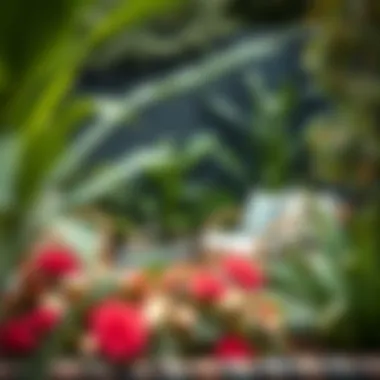

Increasing Usability
When we talk about usability in relation to bedspaces, we are delving into how these structures simplify the gardening process and enhance interaction with the environment.
- Accessibility: Raised bedspaces, for example, can ease the physical strain of gardening, making it more comfortable for individuals who may struggle with bending or kneeling. This accessibility is especially valuable for older adults or those with mobility challenges, creating an inclusive gardening experience.
- Defined Growing Areas: Clearly defined bedspaces help in the organization of diverse plants, preventing overcrowding. By utilizing bedspaces effectively, gardeners can dictate where plants grow, ensuring optimal light and nutrient allocation. Moreover, this organization fosters better crop rotation practices, making it easier to maintain healthy soil.
- Extension of Outdoor Living Areas: Beyond their function as planting areas, bedspaces can serve as focal points around which outdoor activities revolve. They can be adorned with decorative elements such as wooden arbor structures or interspersed with seating areas, enriching the garden as a practical space for social interaction or solitary repose.
Ultimately, the addition of thoughtfully designed bedspaces enhances both the beauty and usability of garden landscapes, fostering environments that are embracing and functional. When planning or improving a garden, one must consider not only how bedspaces look but also how they work—balancing aesthetic and practical considerations for an integrated outdoor experience.
Types of Bedspaces
When contemplating the ideal garden layout, the variety of bedspaces available can profoundly affect not just aesthetic appeal, but also functionality. This section will delve into three primary types of bedspaces: raised, in-ground, and vertical. Each type carries its own unique advantages and considerations, allowing for tailored designs that cater to specific purposes or preferences within the garden.
Raised Bedspaces
Raised bedspaces stand out as a favorite for many gardeners due to their manageable height, making them more accessible and easier to tend to. This form of gardening not only provides a clearer boundary for planting areas but also promotes better soil quality. The soil in raised beds can be deeply enriched, allowing for optimal drainage and enhanced aeration.
- Soil Quality: By filling the bed with a carefully chosen blend of soil, compost, and organic matter, gardeners can create an ideal growing medium, rich in nutrients. This setup helps plants thrive, especially in regions with poor native soil.
- Pest Management: Elevating the plants can also reduce the likelihood of pests like snails and slugs, which often struggle to access the raised height.
- Physical Benefits: People with mobility issues or back pain often find raised beds easier to work with since they do not require as much bending or kneeling.
"Gardening should be a joy, not a backache. Raised beds make sure of that!"
In-ground Bedspaces
In contrast to raised beds, in-ground bedspaces utilize the existing earth. This method is often favored by those who want a more traditional gardening experience. It allows for a seamless interaction with the natural landscape. However, this type does require careful consideration of the native soil’s quality to ensure adequate drainage and nutrients.
- Natural Ecosystem: Utilizing in-ground beds fosters a natural micro-ecosystem, enabling worms and other beneficial insects to aerate the soil, thereby contributing to its health and vitality.
- Variety of Plants: These bedspaces can accommodate larger plants, including shrubs and perennials, given that roots can extend deeply into the earth.
- Cost-Effective: By working directly within the soil, gardeners can often save on materials like timber or concrete needed for raised beds.
Yet, the maintenance of in-ground beds might require more effort, such as tilling and dealing with weeds that spring up from the surrounding soil.
Vertical Bedspaces
As urban spaces become increasingly popular, vertical bedspaces have emerged as an innovative solution for those with limited land area. They allow for creative landscaping while maximizing space, making it especially appealing for small urban gardens or balconies.
- Space Efficiency: Utilizing walls, fences, or specially designed stands, vertical bedspaces can showcase a variety of plants from flowers to vegetables in a small footprint.
- Microclimates: These arrangements can create unique microclimates that protect plants from wind and provide more sun exposure, enhancing growth potential.
- Visual Interest: They also bring an artistic element to gardens. With the right plants, vertical beds become living walls, drawing the eye and inviting curiosity.
Overall, each type of bedspace--raised, in-ground, or vertical--serves a distinct purpose within garden design, offering myriad possibilities for creativity and functionality. Understanding the nuances of these options will empower homeowners and gardeners alike to make informed decisions that elevate their outdoor spaces, ensuring they meet both practical needs and design aspirations.
Benefits of Bedspaces in Gardens
When discussing the myriad ways in which gardens can enrich both our homes and our lives, bedspaces undoubtedly take center stage. These defined areas not only showcase our green thumbs but also yield benefits that resonate deeply with both the environment and our wellbeing. Getting into the nuts and bolts of these advantages can shed light on their importance and utility.
Bedspaces elevate the entire gardening experience, making it more than just an activity; it becomes a deliberate design choice that pays dividends. They facilitate plant growth by improving soil conditions, encourage sustainable practices, and contribute significantly to the health of our flora. By incorporating bedspaces, gardeners, no matter their expertise, are likely to encounter improvements that range from aesthetics to ecological health.
"Bedspaces act as stepping stones leading us toward sustainable gardening and improved ecological responsibility."
Improved Soil Quality
Bedspaces serve as a means for coordinating and enhancing soil quality. By elevating plants, especially in raised bedspaces, the drainage improves significantly, which helps to prevent waterlogging—a common predicament for many traditional gardens. Thus, nutrients are less likely to leach away, allowing the soil to retain what is vital for plant growth.
Additionally, many gardeners choose to fill their bedspaces with a mix of compost and soil tailored to the specific plants they wish to grow. This not only enriches the soil but also offers the opportunity for gardeners to specify nutrient ratios. For instance, if you’re partial to growing tomatoes, a blend with higher potassium can be curated, ensuring your plants not only look good but yield fruit.
- Layering: Using methods like lasagna gardening, one can create a fertile habitat, layering carbon and nitrogen materials, which eventually breaks down into rich compost.
- Soil Testing: Regular testing of soil pH can reveal deficiencies, giving gardeners a chance to address issues specific to their crops.
Sustainable Gardening Practices
When constructed and maintained mindfully, bedspaces promote sustainable gardening practices that benefit not only individual gardens but the broader ecology. For instance, these spaces often utilize reclaimed materials and can be designed to reduce the need for chemical fertilizers and pesticides, creating a more organic gardening experience.
The vertical arrangement of plants in vertical bedspaces has the added edge of enabling higher-density planting, which can maximize yield while minimizing land use. This practice can often lead to reduced water consumption, as elevated beds typically retain moisture better.
- Companion Planting: This concept refers to planting certain flora together for mutual benefit, such as using marigolds to keep pests at bay.
- Crop Rotation: Adjusting what is grown in each bedspace can foster soil health and ward off plant diseases.
Enhanced Plant Health
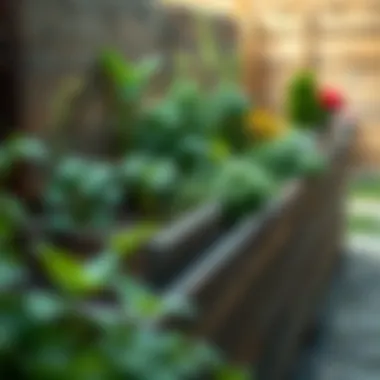
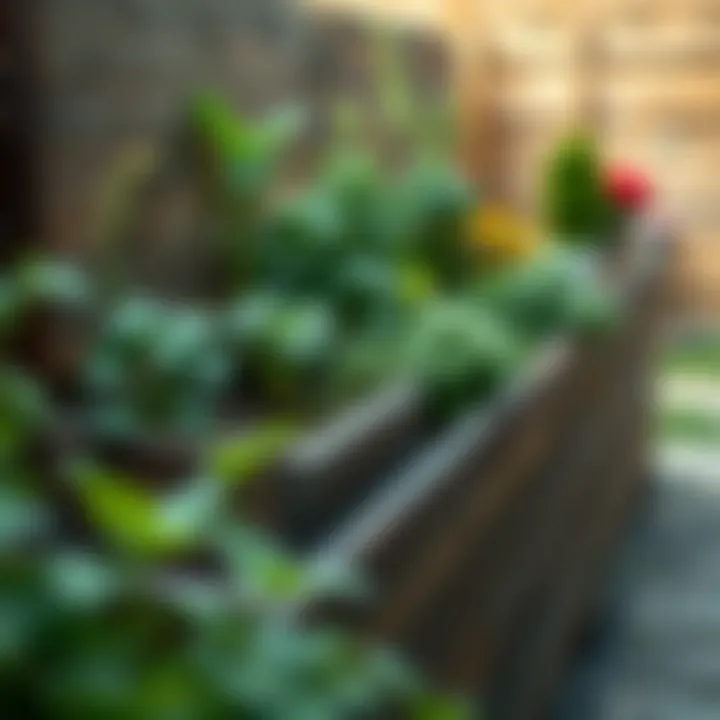
It can't be overstated how bedspaces create an environment where plants thrive. By controlling factors such as moisture, soil type, and access to sunlight, these designated areas allow for careful management that leads to robust growth. Sunlight access can vary depending on how one arranges the bedspaces. Tall plants can provide necessary shade for more delicate crops, thus enhancing the overall health of the garden ecosystem.
Furthermore, well-designed bedspaces can provide easier access for gardeners, allowing them to attend to plants without compacting the surrounding soil. Compacted soil can negatively impact root growth and nutrient uptake, so maintaining a careful walking path around bedspaces will have long-lasting benefits on plant health.
- Pest Management: A well-maintained bedspace, with healthy plants, often remains less attractive to pests, promoting a naturally balanced ecosystem.
- Planting Diversity: A variety of plants within each bedspace can also help to fend off diseases, as the diverse scents and structures can confuse harmful insects.
In summary, the benefits of bedspaces in gardens reach far beyond mere aesthetics. They transform the gardening experience, encourage sustainable and responsible practices, and foster environments where plants can flourish. As we weave these elements into our gardening ethos, we begin to take serious strides towards a healthier and more sustainable future.
Design Considerations
When it comes to creating bedspaces in gardens, design considerations play a significant role in ensuring that these spaces not only fulfill their intended purpose but also seamlessly blend into the overall garden layout. The choices made during the design process can contribute greatly to the aesthetic, functionality, and sustainability of a garden.
Location and Orientation
Choosing the right location for bedspaces is paramount. The exact spot can significantly influence factors such as sunlight exposure, drainage, and soil quality. Placing your bedspace in a well-lit area ensures plants receive adequate sunlight, which is essential for their growth. Conversely, it’s crucial to steer clear of shady spots where plants might struggle. Orientation matters too; north-facing beds in the northern hemisphere can lead to stunted growth due to lack of sun. On the flip side, a south-facing position often basks in sunlight, creating a warm microclimate beneficial for many vegetable and flower varieties.
Furthermore, consider the wind patterns in your area when choosing a location. A bedspace that’s exposed to strong winds might need plants that can withstand such conditions, or a windbreak to shield more delicate varieties. Overall, thoughtful planning of location and orientation can lead to thriving bedspaces, enhancing garden productivity and visual appeal.
Choosing Appropriate Materials
The materials you select for constructing bedspaces have distinct implications for durability, aesthetics, and functionality. Below is a breakdown of common materials:
Wood
Wood is a classic choice for building bedspaces. It's easy to work with and can be sourced sustainably. A key characteristic of wood is its natural insulating properties, which can help in retaining soil warmth. Pressure-treated options resist rot and pests, making them a beneficial choice for a long-lasting bedspace.
However, wood does come with its nuances. Over time, exposed wood can decay or warp, especially if it’s not treated properly. Moreover, concern about using chemically treated wood has been raised, given potential leaching into the soil. Weighing these factors ensures that you select the right type of wood, whether it's cedar, redwood, or an alternative that's suitable for your garden’s ecosystem.
Stone
Stone offers sturdiness and aesthetic appeal, making it another popular option for bedspaces. A critical feature of stone is its ability to retain heat and moisture, creating a stable environment for plants. The natural beauty of stone allows bedspaces to blend harmoniously with the landscape, enhancing the overall visual appeal of a garden.
However, the downside of stone can be its weight and expense. Lifting and placing heavy stones can be labor-intensive, and acquiring them can run up costs. Additionally, because stone heats up quickly in sunlight, it might necessitate careful plant selection to avoid overheating sensitive species.
Composite Materials
Composite materials, which often consist of recycled wood fibers and plastic, are gaining traction for bedspaces due to their low maintenance and durability. One standout characteristic of composite material is its resistance to rot and warping compared to natural wood options. This resilience makes them a popular choice for gardeners looking for longevity without constant upkeep.
Still, composite materials might not resonate with gardeners seeking a more natural look. They can also carry a higher initial cost than traditional wood due to their manufacturing process. Understanding the trade-offs can help in making an informed decision about whether they suit your gardening vision.
Integration with Existing Landscape
Integrating bedspaces into an existing landscape calls for creativity and attention to detail. Consider how the colors, shapes, and styles of the bedspaces interact with other elements in the garden, such as pathways, existing plants, and structures. A well-planned integration enhances not only the aesthetic appeal but also the functionality of the entire garden. Thinking outside the box could mean crafting a curved bedspaceto echo nearby features or strategically placing a bedspace to serve as a focal point.
Environmental Impact
Understanding the environmental impact of integrating bedspaces into gardens cannot be understated. It's not just about beautifying a space; it involves promoting ecological health and sustainability. This section focuses on two pivotal aspects: supporting local biodiversity and managing water effectively. Together, these elements create a vibrant ecosystem that benefits both the garden and the surrounding environment.
Supporting Local Biodiversity
Incorporating bedspaces in gardens has a profound effect on local ecosystems. By providing varied habitats, these structured spaces support a wide range of flora and fauna. When you plant diverse species, you're likely to attract beneficial insects, birds, and even small mammals. For instance, native plants, when paired with your greens, can greatly enhance pollination. Not only does this support local wildlife, but it also promotes a healthy garden. It’s a win-win situation.
"Biodiversity is the cornerstone of resilient ecosystems. Supporting it in our gardens helps maintain the delicate balance of nature."
To maximize support for local biodiversity, consider the following:
- Native Plant Selection: Choose plants that are native to your region. They are more adaptable and require less maintenance while providing the best habitat for local wildlife.
- Seasonal Blooms: Incorporate plants that bloom at different times, ensuring that there are food sources available throughout the year for pollinators.
- Habitat Features: Create small habitats, such as log piles or rock gardens, within bedspaces that can serve as nesting or resting areas for various creatures.
Water Management Considerations
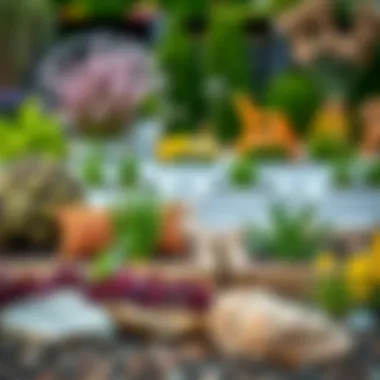
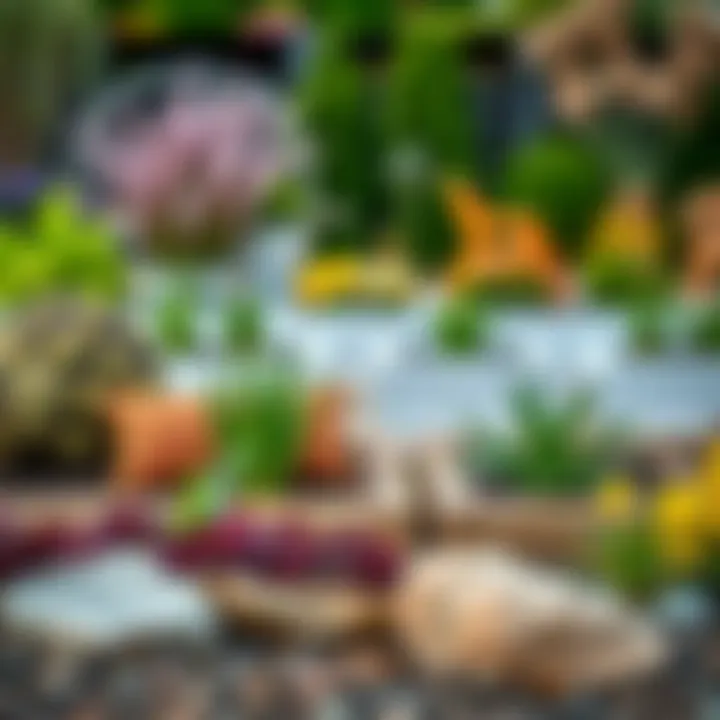
Water management is another crucial component tied into the environmental impact of garden bedspaces. Poor management can lead to water wastage or, conversely, excess runoff, harming both the landscape and local watersheds. Thoughtful design and sustainable practices can mitigate these issues.
To facilitate effective water management:
- Rain Gardens: Design bedspaces that include rain gardens, which capture excess runoff and promote groundwater recharge.
- Soil Health: Adopt practices such as mulching and composting to improve soil structure, which can increase moisture retention.Healthy soil is key for reducing the need for irrigation.
- Irrigation: Utilize smart irrigation systems that adhere to the plants' needs, reducing water waste. Drip irrigation systems, for example, deliver water directly to the roots, minimizing evaporation.
This mindful approach to water management not only conserves resources but also aids in preventing soil erosion and reducing pollution from runoff. Together, these facets of environmental impact underscore the essential role that bedspaces play in crafting a sustainable, thriving outdoor environment.
For more information about urban gardening and its effects on biodiversity, check resources such as Wikipedia and Britannica.
Maintenance of Bedspaces
Maintaining bedspaces is crucial for ensuring not only their longevity but also the vitality of the plants within them. Each element in a garden bed requires careful attention and consideration to keep the ecosystem thriving. This section dives into the essential practices for regular care, and tackles the common issues that gardeners might face, and how to address them effectively.
Regular Care Practices
Keeping your bedspaces in tip-top shape begins with a routine of regular care practices. It's like nurturing a fledgling; attention and care in the early stages can lead to rewarding results down the road.
- Watering: Depending on the climate and type of plants you have, ensuring the right amount of water is essential. Overwatering can be just as damaging as underwatering. A drip irrigation system could be a wise investment, as it provides a steady supply without drowning the roots.
- Weeding: Weeds can be the thorn in a gardener’s side, competing for nutrients and moisture with your plants. Regularly checking your bedspaces and pulling out these unwanted guests before they establish a strong foothold will save you time and effort later on.
- Mulching: Adding a layer of mulch not only helps with moisture retention but also suppresses weeds. Organic mulches can decompose over time, adding nutrients back into the soil. It’s a win-win situation, especially for those looking for a sustainable approach to gardening.
- Fertilizing: Understand the nutritional needs of your plants and apply appropriate fertilizers regularly. Organic options, such as compost, can enhance soil structure and provide nutrients over time rather than just as a one-off boost.
- Monitoring: Keeping an eye out for changes in plant health can give you early warning signs of issues that may arise. Leaf discoloration or wilting could indicate a problem, and a prompt response can salvage the situation.
Addressing Common Issues
Despite diligent care, a gardener might still encounter a few pesky issues along the way. Knowing how to handle them can turn potential disasters into mere bumps in the road.
Pests
Pests can be both a bane and a challenge for any gardener. Certain insects like aphids or snails often consider your garden as a buffet. However, they can also become a part of the relationship we build with our gardens.
- Key Characteristic: Many pests are adaptive and can quickly develop resistance to common pesticides. Thus, understanding their lifecycle and habits is critical.
- Unique Feature: Strategies can include using barriers such as row covers or organic insecticides that target specific pests while preserving beneficial insects. This minimizes disruption to the garden’s ecosystem, turning potential chaos into a manageable outcome.
Diseases
Just like humans, plants can suffer from diseases that hamper their growth and vitality. Issues such as powdery mildew or root rot can stem from a variety of causes including poor airflow and overwatering.
- Key Characteristic: Diseases can spread rapidly, making early identification vital for controlling outbreaks.
- Unique Feature: Implementing crop rotation and ensuring good garden hygiene can drastically reduce the risk of diseases. Understanding how weather conditions impact disease transmission can also equip gardeners with the knowledge they need to take preventive measures.
Nutrient Deficiencies
Plants often show signs of distress through abnormal growth patterns or chlorosis, which can indicate nutritional imbalances.
- Key Characteristic: Each plant has unique nutrient needs that can change throughout its growth cycle.
- Unique Feature: Soil testing is a useful tool for identifying nutrient deficiencies. Correcting these deficiencies with a targeted fertilization approach, whether through natural or synthetic means, ensures that your plants have everything they need to thrive.
Future Trends in Garden Bedspaces
As gardens evolve into multipurpose outdoor living spaces, the role of bedspaces is becoming increasingly significant. Understanding future trends in garden bedspaces is crucial to enhance functionality and sustainability. These trends highlight innovative ways to create appealing structures that benefit both individuals and the environment. Investors and homeowners alike are paying special attention to these advancing concepts to stay ahead in a rapidly changing landscape.
Technological Innovations
In the realm of gardening, technology merges with traditional practices to create innovative bedspace solutions. One of the more intriguing advancements is the introduction of smart gardening systems. These systems can monitor soil moisture levels, temperature, and sunlight exposure, adjusting irrigation settings automatically based on plant needs. For instance, devices like GardenPulse or Grobo not only assist in maintaining optimal conditions but also relay valuable data to the gardener. This kind of tech allows for a more hands-off approach, appealing to busy professionals or those new to gardening.
Another rising trend is the implementation of vertical gardening systems powered by apps. These apps help to select suitable plants based on available sunlight and other environmental factors. Hydroponic and aeroponic bedspaces are also gaining traction, especially in urban areas where space is at a premium. These methods not only maximize the use of limited space but also enhance yield rates, making them a practical choice for urban dwellers.
Additionally, 3D printing technology is making waves in creating customized garden bed designs. From unique shapes to tailored dimensions, home gardeners can now easily print sections that fit their specific needs. Imagine a bespoke raised bed that perfectly suits a narrow area of your yard, crafted to effectively nurture a variety of plants. The combination of technology and personalized design can make any garden a standout.
Adaptations to Climate Change
As climate change prompts shifts in weather patterns and environmental conditions, gardens must adapt. Bedspaces are no exception, as innovative designs and materials come forward to address these challenges. The trend toward drought-resistant plants is one adaptation that homeowners are embracing in their gardening strategies. Cacti, succulents, and other xerophytes are gaining popularity, particularly in regions facing water scarcity.
Moreover, the concept of permaculture is becoming a guiding principle for bedspace design. This approach promotes creating sustainable ecosystems within garden spaces, encouraging biodiversity and resilience. Companion planting, where certain crops are planted together to enhance growth and deter pests, is another strategy that reflects this trend.
Rain gardens also represent a growing concern with water management in beds. By designing beds that capture and filter rainwater, homeowners can prevent runoff while promoting healthier plants. Simple solutions such as swales—shallow ditches designed to redirect water—can effectively manage excessive rain, showcasing adaptability in design.
Just as importantly, implementing native plants within garden bedspaces supports local ecosystems, ensuring that gardens not only thrive but also contribute positively to the environment. Adapting these practices not only aids in combating climate challenges but can also beautify outdoor spaces while promoting sustainability.
"Embracing technology and sustainability is not just the future of gardening; it’s crucial for the preservation of our planet."
In summary, as we forge ahead into a future marked by innovation and environmental awareness, garden bedspaces are positioned at the forefront. By integrating technological tools and applying eco-conscious strategies, those who invest in or design gardens can create thriving, responsible outdoor sanctuaries.





